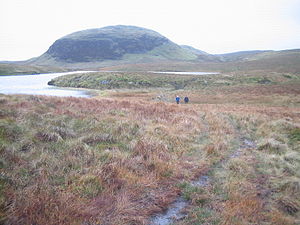- Kilpatrick Hills
-
The Kilpatrick Hills are a range of hills in central Scotland, stretching from Dumbarton in the west to Strathblane in the east. Strathblane divides the Kilpatricks from the Campsie Fells to the east, while to the north is part of the Loch Lomond and the Trossachs National Park. To west and south the hills are fringed by the settlements of Balloch, Dumbarton, Milton, Bowling, Old Kilpatrick, Clydebank, Bearsden and Milngavie. The majority of the range is within West Dunbartonshire, although it extends into the East Dunbartonshire and Stirling areas.
The highest points in the range are Duncolm (1,314 feet (401 m)) and Fynloch (1,313 feet (400 m)). The Kilpatricks offer a number of viewpoints: among the best known are Doughnot Hill and The Whangie. The hills are of volcanic origin, modified by subsequent glaciation.
Contents
Geology
The Kilpatrick Hills are a part the Clyde Plateau Lavas. These are about 340 million years old. Basaltic types of rocks (lavas, tuffs and agglomerates) predominate here. These are produced by denudation of the successive floes.
The Whangie in the north of the Kilpatricks is of particular interest to geologists and casual walkers alike. It consists of a slice of the hillside that has been separated from the main slope. This has created a narrow chasm of about 100 yards (91 m) in length through which visitors can walk. It is the result of glacial plucking. During the ice age, a glacier slowly dragged the frozen crag away from the hillside, causing this chasm to form.
The etymology of the Whangie's name is obscure but it might derive from the old Scots for slice (as in whang o' cheese). Local folklore suggests that it was created by the devil flicking his tail as he flew past.[1]
Topology and toponymy
The hills are named after the village of Old Kilpatrick, which lies at their southern foot. The following table lists summits over 1,000 feet (300 m). Duncolm, the highest point of the range, is also the only Marilyn in the Kilpatricks, having a relative height of over 150 metres (490 ft).[2]
Name Height Coordinates Notes Duncolm 1,314 feet (401 m) 55°57′55.69″N 4°27′4.97″W / 55.9654694°N 4.4513806°W Etymology: Scots Gaelic dun, hill-fort or hill of Colm, (Saint) Columba [1] Fynloch 1,313 feet (400 m) 55°57′41.6″N 4°28′0.81″W / 55.961556°N 4.4668917°W Middle Duncolm 1,289 feet (393 m) 55°57′46.7″N 4°27′26.98″W / 55.962972°N 4.4574944°W Darnycaip 1,232 feet (376 m) 55°57′36.97″N 4°29′4.33″W / 55.9602694°N 4.4845361°W Doughnot Hill 1,227 feet (374 m) 55°58′0.55″N 4°29′21.67″W / 55.9668194°N 4.4893528°W The Slacks 1,199 feet (365 m) Auchineden 1,171 feet (357 m) Craigarestie 1,166 feet (355 m) Meikle White Hill 1,163 feet (354 m) Berry Bank 1,152 feet (351 m) Brown Hill 1,149 feet (350 m) Cochno Hill 1,140 feet (350 m) Knockupple 1,116 feet (340 m) Craighirst 1,074 feet (327 m) Thief's Hill 1,026 feet (313 m) See also
- List of mountains in Scotland
- Maiden Paps
- Breast shaped hills
References
- ^ a b Drummond, Peter (2007) Scottish Hill Names: Their Origin & Meaning. p166
- ^ Dawson, Alan. "Region 26 Central Scotland from Dumbarton to Montrose". The Relative Hills of Britain. http://bubl.ac.uk/org/tacit/marilyns/region26.htm.
External links
Categories:- Hills of the Scottish Midland Valley
- Protected areas of West Dunbartonshire
Wikimedia Foundation. 2010.



